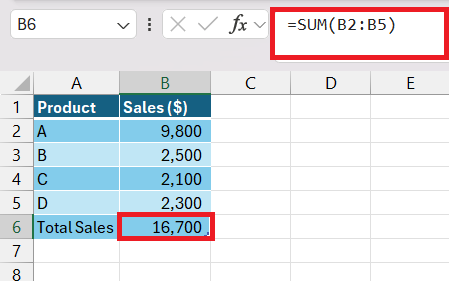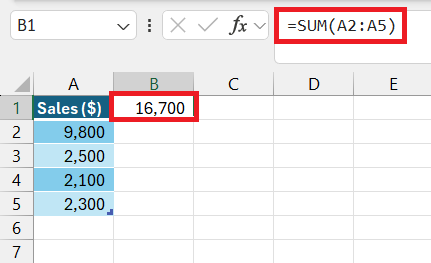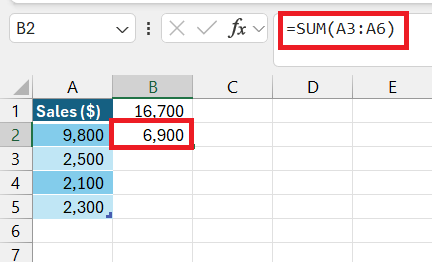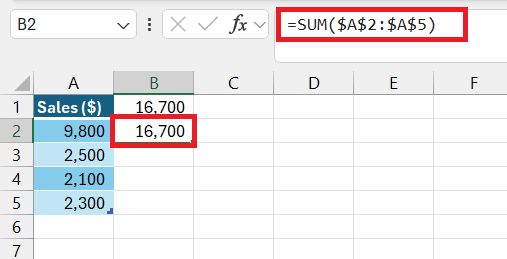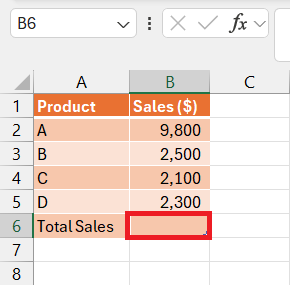Microsoft Excel is a powerful tool for managing and analyzing data, and one of its most fundamental functions is summing values in a column. Whether you’re tracking expenses, calculating totals, or performing data analysis, knowing how to sum a column can streamline your workflow. This article will guide you through various methods to sum a column in Excel, including using the AutoSum feature, the SUM function, and other efficient techniques
Key Takeaways:
- Introduction to Summing Columns in Excel: Understanding how to sum a column in Excel is essential for efficient data management and analysis.
- Importance of Mastering the SUM Function: The SUM function is a foundational tool in Excel, crucial for a wide range of calculations and data analysis tasks.
- Utilizing AutoSum for Efficiency: AutoSum is a quick and easy way to sum columns in Excel, saving time and enhancing productivity.
- Understanding Cell References: Knowing the difference between relative, absolute, and mixed cell references ensures accurate summation across spreadsheets.
- Handling Errors and Special Cases: Techniques like the AGGREGATE and SUBTOTAL functions help manage errors and sum only visible cells, maintaining data integrity.
Table of Contents
Introduction to Summing Columns in Excel
Why Mastering the SUM Function is Essential
Mastering the SUM function in Excel is like having a Swiss Army knife for your data analysis. It’s the foundation upon which many other functions and more complex analyses are built. Think of it as your go-to tool for quickly adding up numbers across rows and columns, giving you the power to turn raw data into meaningful information.
Whether you’re managing budgets, performing accounting tasks, or simply need to tally up a list of figures, learning to effectively use the SUM function will save you time and minimize errors. Plus, with the rise of data-driven decisions in nearly every sector, it’s no overstatement to say that these simple summation skills could be critical to your success on the job.
A Brief Overview of Excel’s Calculation Abilities
Excel’s calculation abilities are like a treasure chest for number crunchers. This robust application can handle everything from simple arithmetic to complex financial analyses, thanks to its wide array of functions and formulas. At its core is the ability to perform basic operations such as addition, subtraction, multiplication, and division. But beyond these lie more sophisticated features like statistical analysis, logical operations, and even lookup and reference capabilities.
Users can create formulas that automatically update results based on changes to input data, which means your spreadsheets are always current. You can also use range functions to perform calculations on large sets of data or employ pivot tables for summarizing data in interactive ways. Excel’s ability to nest functions—using one function inside another —opens up even more possibilities for dynamic calculations.
From forecasting trends to budgeting, or even working with time and dates, Excel’s computational prowess enables you to make sense of and utilize your data effectively. It’s this powerful flexibility that makes Excel a go-to solution for data analysis tasks across various industries.
Getting Started with Basic SUM
How to Sum a Column in Excel
The classic =SUM formula is your straightforward, no-fuss way of adding up numbers in Excel. It works by totaling the values in a range of cells that you specify. Here’s how it looks:
=SUM(number1, [number2], [number3], ...)
In this formula, number1, number2, number3, etc., can be either individual numbers, cell references, or range references. When you use a range reference, Excel sums all the numbers within that range. For example, =SUM(A1:A10) will give you the total of all numbers from cell A1 down to A10.
Just remember, the SUM function only works with numbers. If there are any text entries in your range, they will be ignored. The beauty of the SUM formula lies in its ability to handle up to 255 individual arguments, which means you can sum numbers across multiple ranges and standalone cells within the same formula.
For a quick sum, you might write something simple like =SUM(B2:B5), and Excel will do the math to display the total of the cells B2 through B5.
It’s an essential tool for everyday spreadsheet tasks and once you get the hang of it, you’ll be adding columns of figures with the speed and ease of an Excel pro.
Understanding Cell References for Accurate Summation
Understanding cell references is key to accurate summation in Excel. There are three types of cell references: relative, absolute, and mixed. But don’t let the jargon intimidate you — they’re quite straightforward once you get to know them.
Relative references change when a formula is copied to another cell. For example, if your formula in cell B1 is =SUM(A2:A5) .
When you copy it to B2, the formula automatically adjusts to =SUM(A2:A6). This is because Excel assumes you want a similar calculation relative to the position of the new cell.
Absolute references, on the other hand, remain constant no matter where they are copied. They are denoted by dollar signs, like so: =SUM($A$2:$A$5). If you copy this formula from B1 to B2, it will remain =SUM($A$2:$A$5) in B2, ensuring the same range is summed regardless of where the formula is placed.
Mixed references are a combination of relative and absolute references, where either the row or the column remains fixed. For example, =SUM(A$2:A$5) keeps the row constant but allows the column to adjust when the formula is copied across columns.
Knowing how to use these references will help prevent errors and ensure your SUM formulas always refer to the correct cells, especially when duplicating formulas across large spreadsheets.
Advancing Your Skills with SUM Variations
Utilizing AutoSum for Efficiency
Utilizing AutoSum is like having a trusty assistant do the legwork for you. It’s the quicker, more efficient sibling of the classic SUM function and gets the job done with just a couple of clicks—or even faster with a keyboard shortcut. Imagine wanting to sum a column of numbers: instead of typing out the entire formula, follow these steps:
STEP 1: Select the cell where you want the sum value to appear.
STEP 2: Now, simply head over to the ‘Home’ tab, and find the ‘Editing’ group.
STEP 3: Hit the AutoSum button. Voilà, Excel smartly suggests the most likely range of cells you wish to total.
A pro tip for those who love keyboard shortcuts: by pressing ALT + =, you can instantly trigger AutoSum and, with the tap of the Enter key, your sum formula is ready to go. This can be particularly handy when working with large datasets where time-saving tricks translate into tangible productivity boosts.
And if Excel doesn’t pick the exact range you need, no sweat! Just drag through the cells you want to include and hit Enter. AutoSum is flexible and easily correctible, making summing up numbers a breeze.
FAQ: Your Summing Column Queries Answered
How do I sum an entire column in Excel?
To sum an entire column in Excel without specifying a range, use the SUM function with a full column reference. For example, type =SUM(A:A) in a cell, which sums all numbers in column A. As you add data, the formula automatically updates to include the new figures, providing an up-to-date total. This method is highly efficient for ongoing data entry.
What is the formula for total sum in Excel?
The formula for a total sum in Excel is the SUM function. You would enter =SUM(range) into a cell, replacing ‘range’ with the cells you want to total, like =SM(A1:A10). This will add up all the numbers from cell A1 to A10. It’s the standard way to calculate a sum in Excel and is versatile enough to handle multiple ranges and non-adjacent cells by separating them with commas.
How Can I Sum Multiple Columns at Once?
To sum multiple columns at once in Excel, you’ll utilize the SUM function across several ranges. Simply type =SUM(range1, range2, range3, ...), replacing ‘range1’, ‘range2’, and ‘range3’ with your specific column ranges. For example, =SUM(A1:A10, B1:B10, C1:C10) would sum up cells in columns A, B, and C from the 1st to the 10th row. It’s an effective approach to aggregate data from different sections of your spreadsheet quickly.
What If My Column Contains Errors or Blank Cells?
If your column contains errors or blank cells, you still have options to calculate a sum. Use the aggregate function =AGGREGATE(9, 6, range) where ‘range’ is your column. The ‘9’ indicates a sum, and the ‘6’ tells Excel to ignore errors. For blank cells, they’re a non-issue; Excel’s SUM function automatically skips these. However, if there are zeroes you want to ignore, you could use a SUMIF formula to sum cells only if they are not equal to zero, like =SUMIF(range, "<>0").
How do I sum just visible cells?
To sum just the visible cells after filtering in Excel, you use the SUBTOTAL function. Specifically, =SUBTOTAL(109, range) is designed for this task, where ‘range’ is the cells you’re summing. The ‘109’ function code tells Excel to add up only visible cells within the range, ignoring any that have been hidden. This ensures that your sum remains accurate even as you apply different filters to your data.
John Michaloudis is a former accountant and finance analyst at General Electric, a Microsoft MVP since 2020, an Amazon #1 bestselling author of 4 Microsoft Excel books and teacher of Microsoft Excel & Office over at his flagship MyExcelOnline Academy Online Course.

